Analysis of Big Data in Higher Education: WM00H-10 Report
VerifiedAdded on 2022/09/06
|25
|6441
|14
Report
AI Summary
This report examines the utilization of big data in the higher education sector, addressing its challenges and opportunities. It delves into the key features of big data, including volume, variety, velocity, and variability, and outlines the steps involved in big data processing: data collection, data analysis, and data visualization. The report discusses data mining techniques, including clustering, classification, and regression, and highlights various technologies. It also considers factors to be considered when moving to big data and the risks associated with implementation, offering recommendations for effective adoption. The report emphasizes the significance of data analysis, data warehousing, and the use of analytics tools to process and analyze data within the education sector.
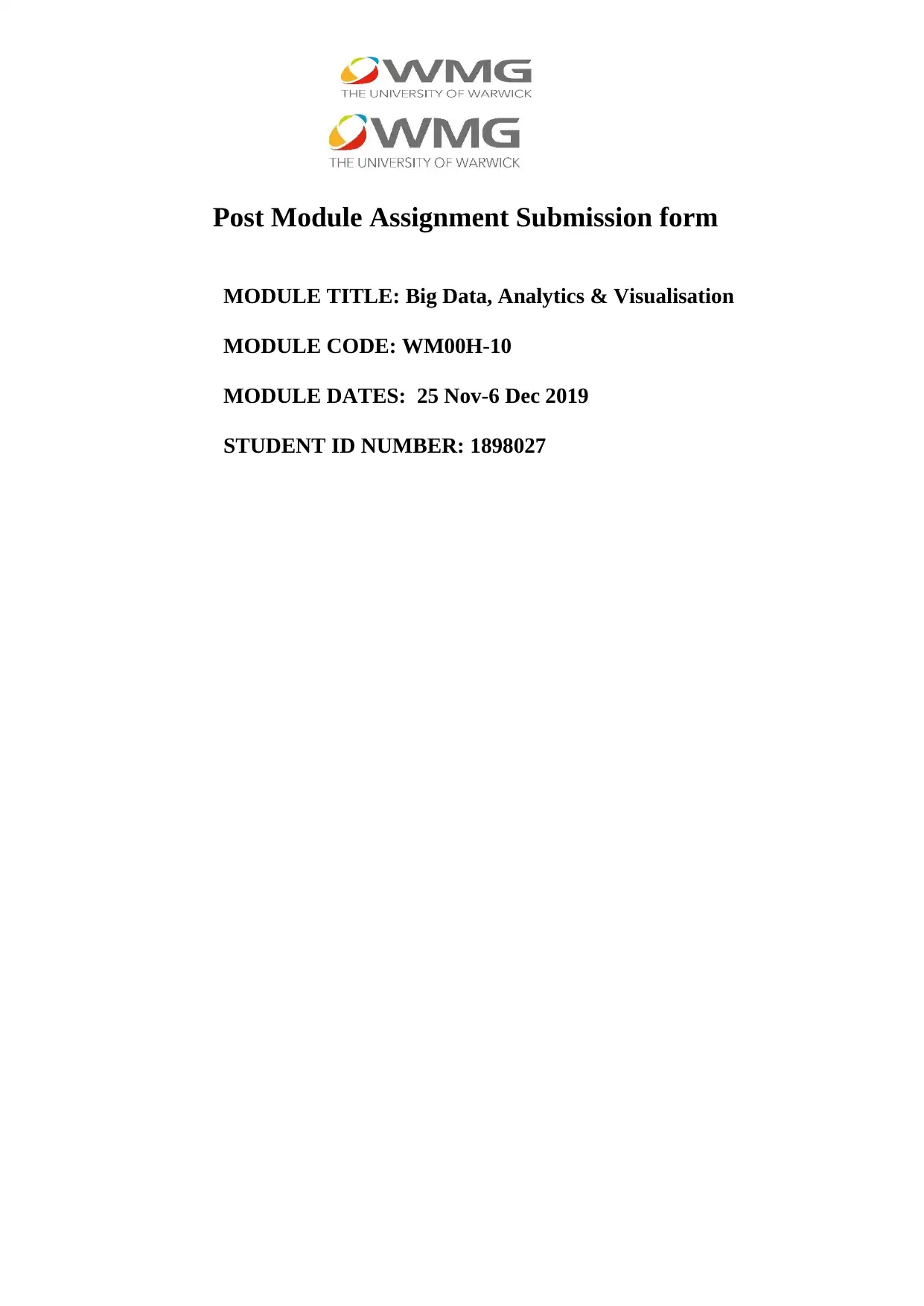
Post Module Assignment Submission form
MODULE TITLE: Big Data, Analytics & Visualisation
MODULE CODE: WM00H-10
MODULE DATES: 25 Nov-6 Dec 2019
STUDENT ID NUMBER: 1898027
MODULE TITLE: Big Data, Analytics & Visualisation
MODULE CODE: WM00H-10
MODULE DATES: 25 Nov-6 Dec 2019
STUDENT ID NUMBER: 1898027
Paraphrase This Document
Need a fresh take? Get an instant paraphrase of this document with our AI Paraphraser
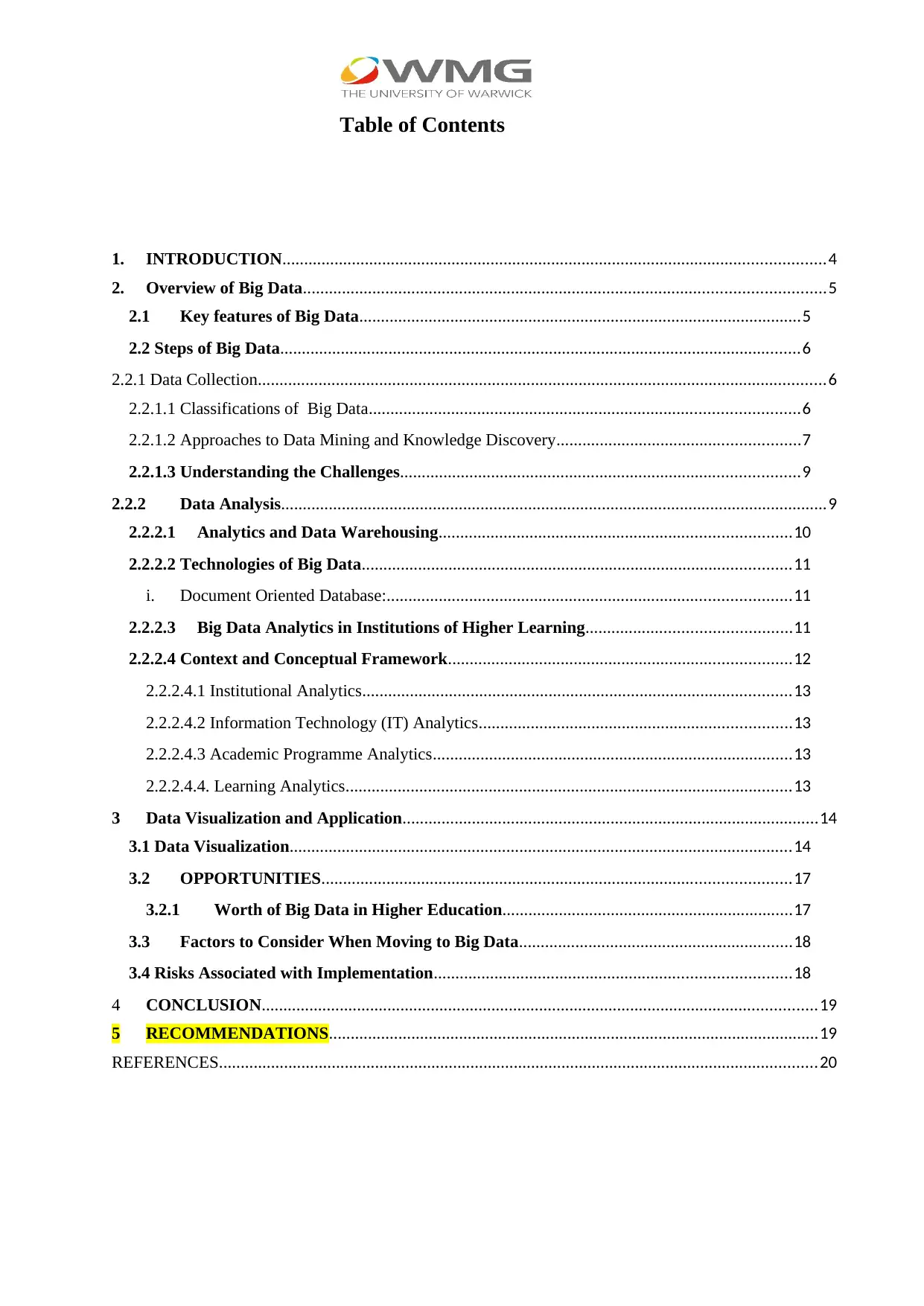
Table of Contents
1. INTRODUCTION.............................................................................................................................4
2. Overview of Big Data........................................................................................................................5
2.1 Key features of Big Data......................................................................................................5
2.2 Steps of Big Data........................................................................................................................6
2.2.1 Data Collection...................................................................................................................................6
2.2.1.1 Classifications of Big Data...................................................................................................6
2.2.1.2 Approaches to Data Mining and Knowledge Discovery........................................................7
2.2.1.3 Understanding the Challenges............................................................................................9
2.2.2 Data Analysis..............................................................................................................................9
2.2.2.1 Analytics and Data Warehousing.................................................................................10
2.2.2.2 Technologies of Big Data...................................................................................................11
i. Document Oriented Database:.............................................................................................11
2.2.2.3 Big Data Analytics in Institutions of Higher Learning...............................................11
2.2.2.4 Context and Conceptual Framework...............................................................................12
2.2.2.4.1 Institutional Analytics...................................................................................................13
2.2.2.4.2 Information Technology (IT) Analytics........................................................................13
2.2.2.4.3 Academic Programme Analytics...................................................................................13
2.2.2.4.4. Learning Analytics.......................................................................................................13
3 Data Visualization and Application................................................................................................14
3.1 Data Visualization....................................................................................................................14
3.2 OPPORTUNITIES............................................................................................................17
3.2.1 Worth of Big Data in Higher Education...................................................................17
3.3 Factors to Consider When Moving to Big Data...............................................................18
3.4 Risks Associated with Implementation..................................................................................18
4 CONCLUSION................................................................................................................................19
5 RECOMMENDATIONS.................................................................................................................19
REFERENCES..........................................................................................................................................20
1. INTRODUCTION.............................................................................................................................4
2. Overview of Big Data........................................................................................................................5
2.1 Key features of Big Data......................................................................................................5
2.2 Steps of Big Data........................................................................................................................6
2.2.1 Data Collection...................................................................................................................................6
2.2.1.1 Classifications of Big Data...................................................................................................6
2.2.1.2 Approaches to Data Mining and Knowledge Discovery........................................................7
2.2.1.3 Understanding the Challenges............................................................................................9
2.2.2 Data Analysis..............................................................................................................................9
2.2.2.1 Analytics and Data Warehousing.................................................................................10
2.2.2.2 Technologies of Big Data...................................................................................................11
i. Document Oriented Database:.............................................................................................11
2.2.2.3 Big Data Analytics in Institutions of Higher Learning...............................................11
2.2.2.4 Context and Conceptual Framework...............................................................................12
2.2.2.4.1 Institutional Analytics...................................................................................................13
2.2.2.4.2 Information Technology (IT) Analytics........................................................................13
2.2.2.4.3 Academic Programme Analytics...................................................................................13
2.2.2.4.4. Learning Analytics.......................................................................................................13
3 Data Visualization and Application................................................................................................14
3.1 Data Visualization....................................................................................................................14
3.2 OPPORTUNITIES............................................................................................................17
3.2.1 Worth of Big Data in Higher Education...................................................................17
3.3 Factors to Consider When Moving to Big Data...............................................................18
3.4 Risks Associated with Implementation..................................................................................18
4 CONCLUSION................................................................................................................................19
5 RECOMMENDATIONS.................................................................................................................19
REFERENCES..........................................................................................................................................20

Table of Figures
Figure 1.
Figure 2.
Figure 3.
Figure 4.
Figure 5.
Figure 1.
Figure 2.
Figure 3.
Figure 4.
Figure 5.
⊘ This is a preview!⊘
Do you want full access?
Subscribe today to unlock all pages.

Trusted by 1+ million students worldwide
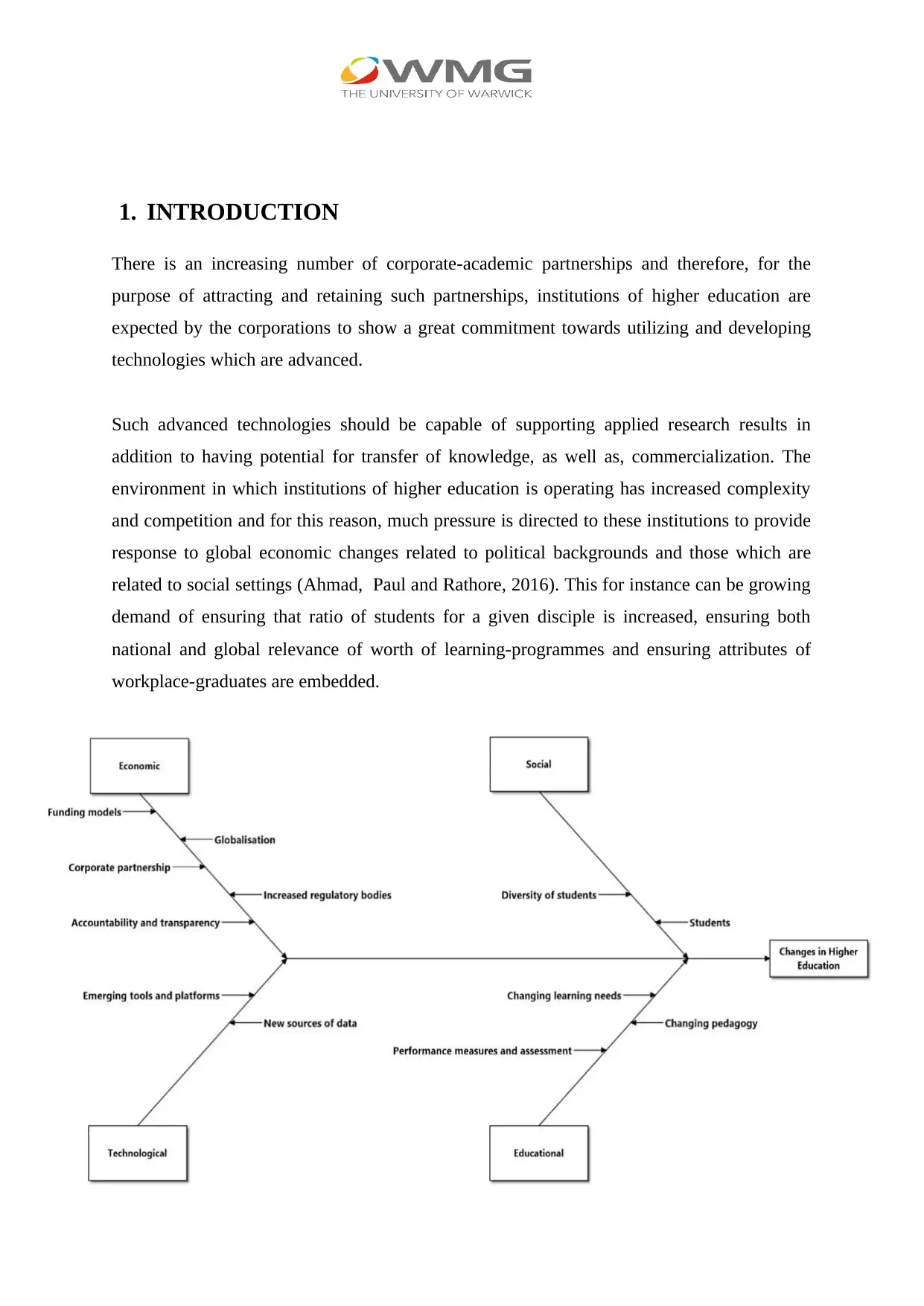
1. INTRODUCTION
There is an increasing number of corporate-academic partnerships and therefore, for the
purpose of attracting and retaining such partnerships, institutions of higher education are
expected by the corporations to show a great commitment towards utilizing and developing
technologies which are advanced.
Such advanced technologies should be capable of supporting applied research results in
addition to having potential for transfer of knowledge, as well as, commercialization. The
environment in which institutions of higher education is operating has increased complexity
and competition and for this reason, much pressure is directed to these institutions to provide
response to global economic changes related to political backgrounds and those which are
related to social settings (Ahmad, Paul and Rathore, 2016). This for instance can be growing
demand of ensuring that ratio of students for a given disciple is increased, ensuring both
national and global relevance of worth of learning-programmes and ensuring attributes of
workplace-graduates are embedded.
There is an increasing number of corporate-academic partnerships and therefore, for the
purpose of attracting and retaining such partnerships, institutions of higher education are
expected by the corporations to show a great commitment towards utilizing and developing
technologies which are advanced.
Such advanced technologies should be capable of supporting applied research results in
addition to having potential for transfer of knowledge, as well as, commercialization. The
environment in which institutions of higher education is operating has increased complexity
and competition and for this reason, much pressure is directed to these institutions to provide
response to global economic changes related to political backgrounds and those which are
related to social settings (Ahmad, Paul and Rathore, 2016). This for instance can be growing
demand of ensuring that ratio of students for a given disciple is increased, ensuring both
national and global relevance of worth of learning-programmes and ensuring attributes of
workplace-graduates are embedded.
Paraphrase This Document
Need a fresh take? Get an instant paraphrase of this document with our AI Paraphraser
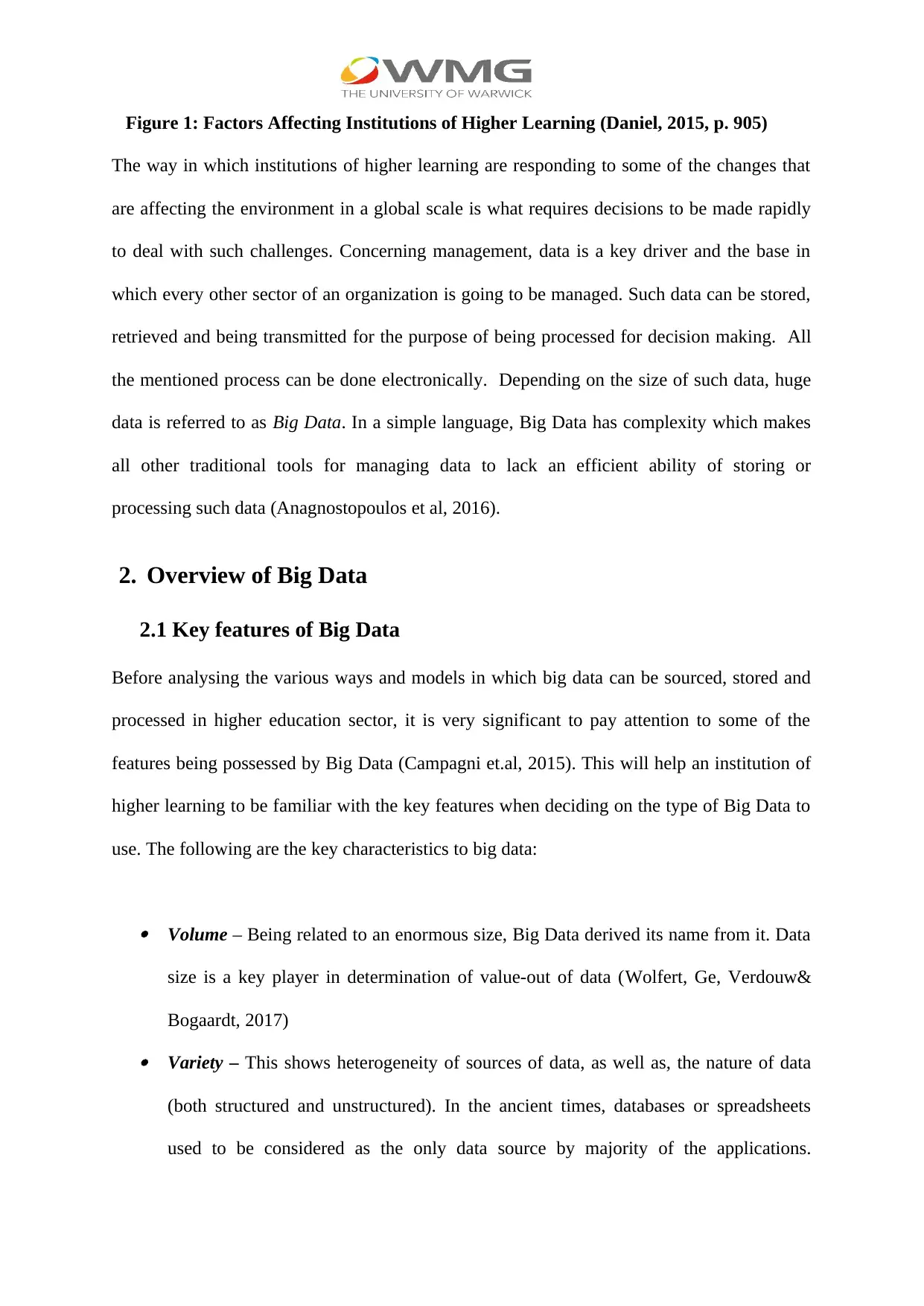
Figure 1: Factors Affecting Institutions of Higher Learning (Daniel, 2015, p. 905)
The way in which institutions of higher learning are responding to some of the changes that
are affecting the environment in a global scale is what requires decisions to be made rapidly
to deal with such challenges. Concerning management, data is a key driver and the base in
which every other sector of an organization is going to be managed. Such data can be stored,
retrieved and being transmitted for the purpose of being processed for decision making. All
the mentioned process can be done electronically. Depending on the size of such data, huge
data is referred to as Big Data. In a simple language, Big Data has complexity which makes
all other traditional tools for managing data to lack an efficient ability of storing or
processing such data (Anagnostopoulos et al, 2016).
2. Overview of Big Data
2.1 Key features of Big Data
Before analysing the various ways and models in which big data can be sourced, stored and
processed in higher education sector, it is very significant to pay attention to some of the
features being possessed by Big Data (Campagni et.al, 2015). This will help an institution of
higher learning to be familiar with the key features when deciding on the type of Big Data to
use. The following are the key characteristics to big data:
Volume – Being related to an enormous size, Big Data derived its name from it. Data
size is a key player in determination of value-out of data (Wolfert, Ge, Verdouw&
Bogaardt, 2017) Variety – This shows heterogeneity of sources of data, as well as, the nature of data
(both structured and unstructured). In the ancient times, databases or spreadsheets
used to be considered as the only data source by majority of the applications.
The way in which institutions of higher learning are responding to some of the changes that
are affecting the environment in a global scale is what requires decisions to be made rapidly
to deal with such challenges. Concerning management, data is a key driver and the base in
which every other sector of an organization is going to be managed. Such data can be stored,
retrieved and being transmitted for the purpose of being processed for decision making. All
the mentioned process can be done electronically. Depending on the size of such data, huge
data is referred to as Big Data. In a simple language, Big Data has complexity which makes
all other traditional tools for managing data to lack an efficient ability of storing or
processing such data (Anagnostopoulos et al, 2016).
2. Overview of Big Data
2.1 Key features of Big Data
Before analysing the various ways and models in which big data can be sourced, stored and
processed in higher education sector, it is very significant to pay attention to some of the
features being possessed by Big Data (Campagni et.al, 2015). This will help an institution of
higher learning to be familiar with the key features when deciding on the type of Big Data to
use. The following are the key characteristics to big data:
Volume – Being related to an enormous size, Big Data derived its name from it. Data
size is a key player in determination of value-out of data (Wolfert, Ge, Verdouw&
Bogaardt, 2017) Variety – This shows heterogeneity of sources of data, as well as, the nature of data
(both structured and unstructured). In the ancient times, databases or spreadsheets
used to be considered as the only data source by majority of the applications.
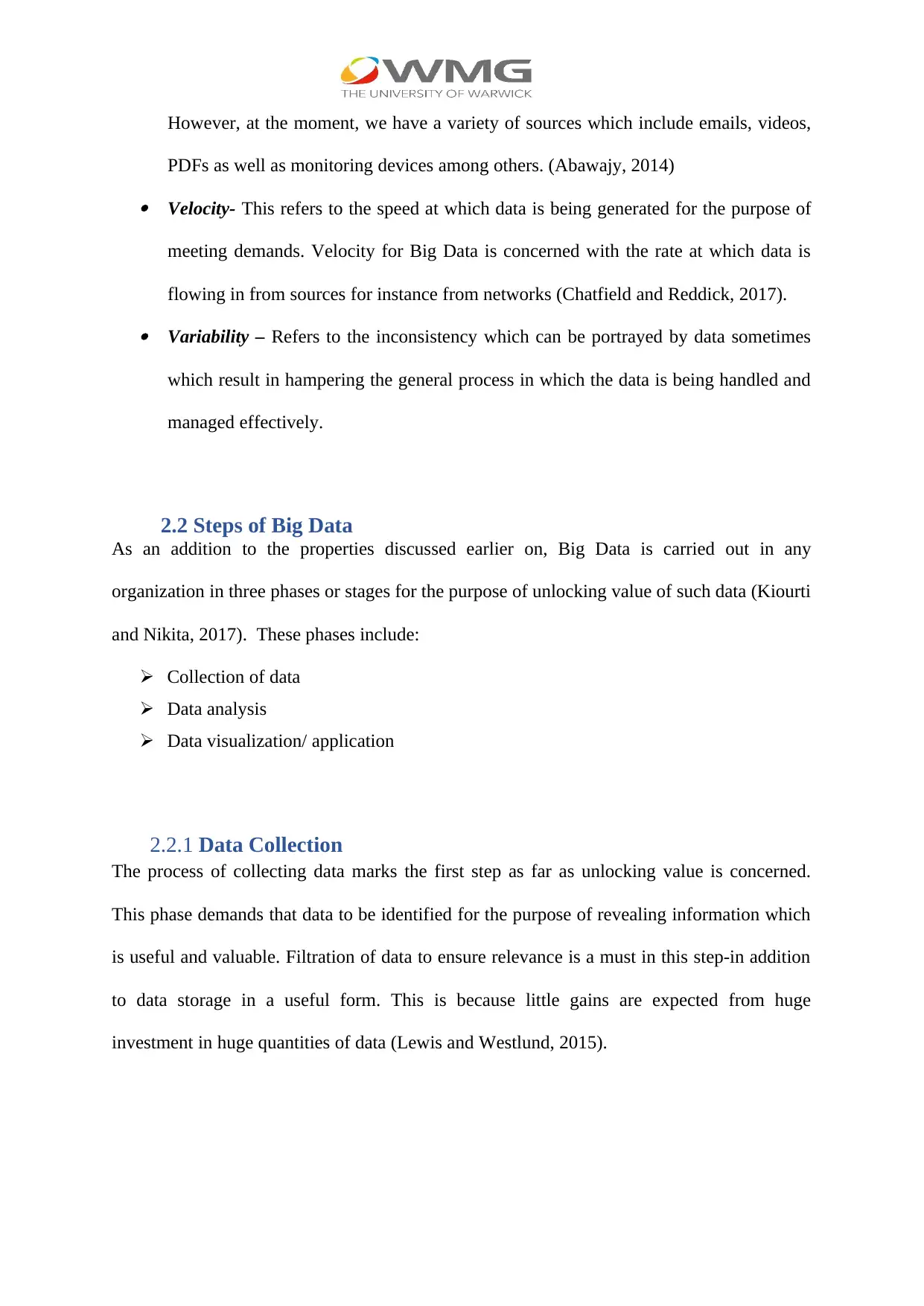
However, at the moment, we have a variety of sources which include emails, videos,
PDFs as well as monitoring devices among others. (Abawajy, 2014) Velocity- This refers to the speed at which data is being generated for the purpose of
meeting demands. Velocity for Big Data is concerned with the rate at which data is
flowing in from sources for instance from networks (Chatfield and Reddick, 2017). Variability – Refers to the inconsistency which can be portrayed by data sometimes
which result in hampering the general process in which the data is being handled and
managed effectively.
2.2 Steps of Big Data
As an addition to the properties discussed earlier on, Big Data is carried out in any
organization in three phases or stages for the purpose of unlocking value of such data (Kiourti
and Nikita, 2017). These phases include:
Collection of data
Data analysis
Data visualization/ application
2.2.1 Data Collection
The process of collecting data marks the first step as far as unlocking value is concerned.
This phase demands that data to be identified for the purpose of revealing information which
is useful and valuable. Filtration of data to ensure relevance is a must in this step-in addition
to data storage in a useful form. This is because little gains are expected from huge
investment in huge quantities of data (Lewis and Westlund, 2015).
PDFs as well as monitoring devices among others. (Abawajy, 2014) Velocity- This refers to the speed at which data is being generated for the purpose of
meeting demands. Velocity for Big Data is concerned with the rate at which data is
flowing in from sources for instance from networks (Chatfield and Reddick, 2017). Variability – Refers to the inconsistency which can be portrayed by data sometimes
which result in hampering the general process in which the data is being handled and
managed effectively.
2.2 Steps of Big Data
As an addition to the properties discussed earlier on, Big Data is carried out in any
organization in three phases or stages for the purpose of unlocking value of such data (Kiourti
and Nikita, 2017). These phases include:
Collection of data
Data analysis
Data visualization/ application
2.2.1 Data Collection
The process of collecting data marks the first step as far as unlocking value is concerned.
This phase demands that data to be identified for the purpose of revealing information which
is useful and valuable. Filtration of data to ensure relevance is a must in this step-in addition
to data storage in a useful form. This is because little gains are expected from huge
investment in huge quantities of data (Lewis and Westlund, 2015).
⊘ This is a preview!⊘
Do you want full access?
Subscribe today to unlock all pages.

Trusted by 1+ million students worldwide
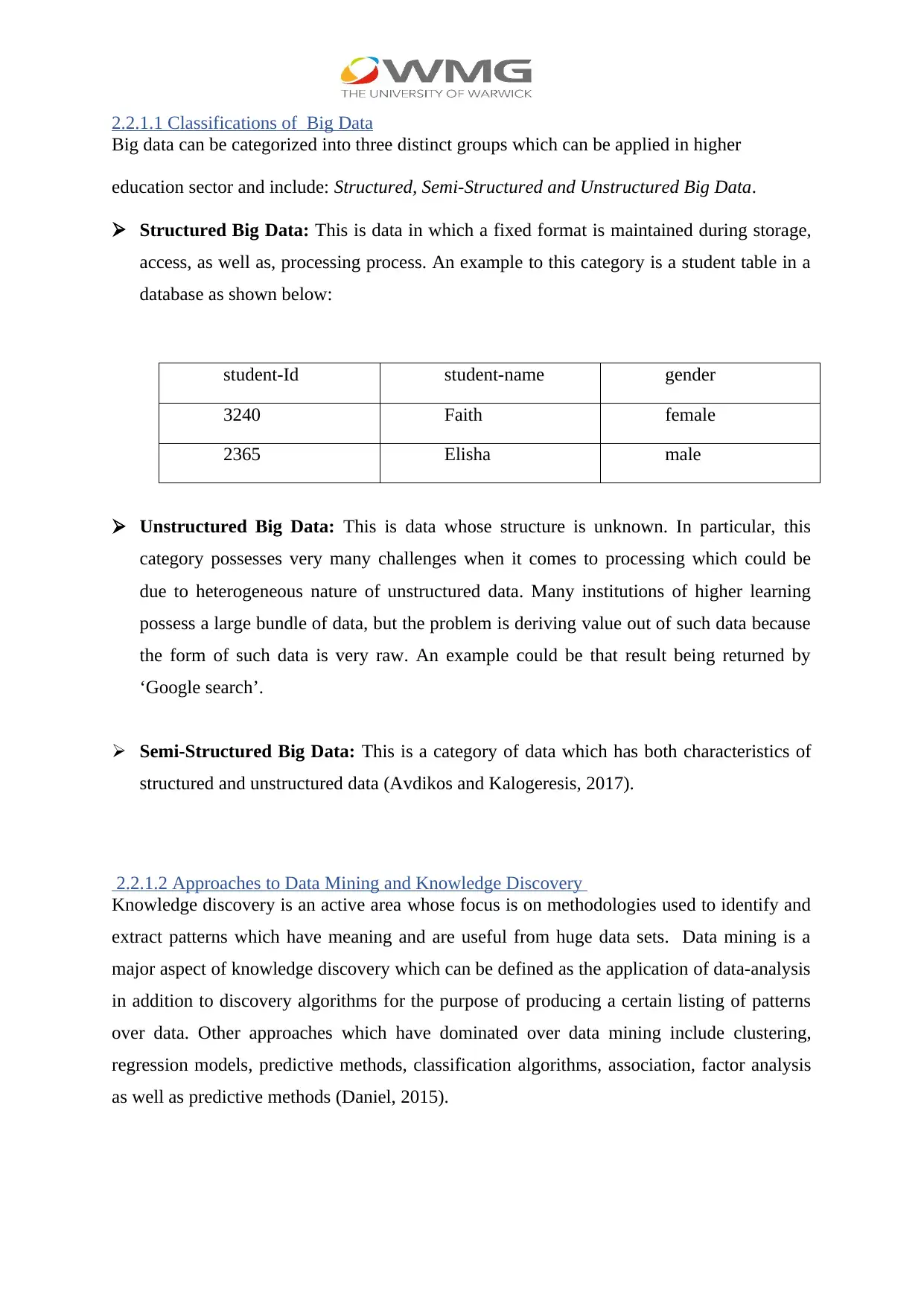
2.2.1.1 Classifications of Big Data
Big data can be categorized into three distinct groups which can be applied in higher
education sector and include: Structured, Semi-Structured and Unstructured Big Data.
Structured Big Data: This is data in which a fixed format is maintained during storage,
access, as well as, processing process. An example to this category is a student table in a
database as shown below:
student-Id student-name gender
3240 Faith female
2365 Elisha male
Unstructured Big Data: This is data whose structure is unknown. In particular, this
category possesses very many challenges when it comes to processing which could be
due to heterogeneous nature of unstructured data. Many institutions of higher learning
possess a large bundle of data, but the problem is deriving value out of such data because
the form of such data is very raw. An example could be that result being returned by
‘Google search’.
Semi-Structured Big Data: This is a category of data which has both characteristics of
structured and unstructured data (Avdikos and Kalogeresis, 2017).
2.2.1.2 Approaches to Data Mining and Knowledge Discovery
Knowledge discovery is an active area whose focus is on methodologies used to identify and
extract patterns which have meaning and are useful from huge data sets. Data mining is a
major aspect of knowledge discovery which can be defined as the application of data-analysis
in addition to discovery algorithms for the purpose of producing a certain listing of patterns
over data. Other approaches which have dominated over data mining include clustering,
regression models, predictive methods, classification algorithms, association, factor analysis
as well as predictive methods (Daniel, 2015).
Big data can be categorized into three distinct groups which can be applied in higher
education sector and include: Structured, Semi-Structured and Unstructured Big Data.
Structured Big Data: This is data in which a fixed format is maintained during storage,
access, as well as, processing process. An example to this category is a student table in a
database as shown below:
student-Id student-name gender
3240 Faith female
2365 Elisha male
Unstructured Big Data: This is data whose structure is unknown. In particular, this
category possesses very many challenges when it comes to processing which could be
due to heterogeneous nature of unstructured data. Many institutions of higher learning
possess a large bundle of data, but the problem is deriving value out of such data because
the form of such data is very raw. An example could be that result being returned by
‘Google search’.
Semi-Structured Big Data: This is a category of data which has both characteristics of
structured and unstructured data (Avdikos and Kalogeresis, 2017).
2.2.1.2 Approaches to Data Mining and Knowledge Discovery
Knowledge discovery is an active area whose focus is on methodologies used to identify and
extract patterns which have meaning and are useful from huge data sets. Data mining is a
major aspect of knowledge discovery which can be defined as the application of data-analysis
in addition to discovery algorithms for the purpose of producing a certain listing of patterns
over data. Other approaches which have dominated over data mining include clustering,
regression models, predictive methods, classification algorithms, association, factor analysis
as well as predictive methods (Daniel, 2015).
Paraphrase This Document
Need a fresh take? Get an instant paraphrase of this document with our AI Paraphraser
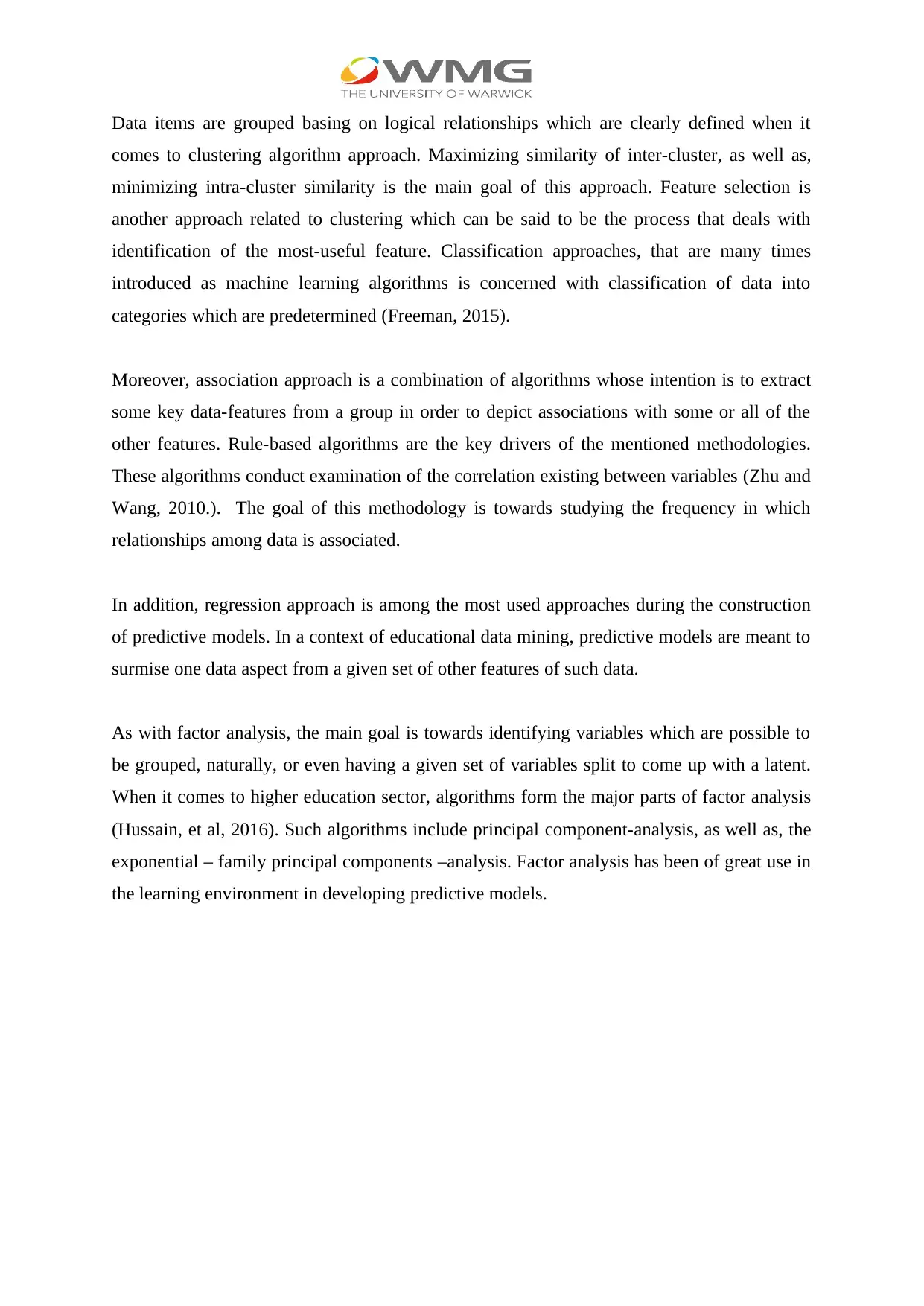
Data items are grouped basing on logical relationships which are clearly defined when it
comes to clustering algorithm approach. Maximizing similarity of inter-cluster, as well as,
minimizing intra-cluster similarity is the main goal of this approach. Feature selection is
another approach related to clustering which can be said to be the process that deals with
identification of the most-useful feature. Classification approaches, that are many times
introduced as machine learning algorithms is concerned with classification of data into
categories which are predetermined (Freeman, 2015).
Moreover, association approach is a combination of algorithms whose intention is to extract
some key data-features from a group in order to depict associations with some or all of the
other features. Rule-based algorithms are the key drivers of the mentioned methodologies.
These algorithms conduct examination of the correlation existing between variables (Zhu and
Wang, 2010.). The goal of this methodology is towards studying the frequency in which
relationships among data is associated.
In addition, regression approach is among the most used approaches during the construction
of predictive models. In a context of educational data mining, predictive models are meant to
surmise one data aspect from a given set of other features of such data.
As with factor analysis, the main goal is towards identifying variables which are possible to
be grouped, naturally, or even having a given set of variables split to come up with a latent.
When it comes to higher education sector, algorithms form the major parts of factor analysis
(Hussain, et al, 2016). Such algorithms include principal component-analysis, as well as, the
exponential – family principal components –analysis. Factor analysis has been of great use in
the learning environment in developing predictive models.
comes to clustering algorithm approach. Maximizing similarity of inter-cluster, as well as,
minimizing intra-cluster similarity is the main goal of this approach. Feature selection is
another approach related to clustering which can be said to be the process that deals with
identification of the most-useful feature. Classification approaches, that are many times
introduced as machine learning algorithms is concerned with classification of data into
categories which are predetermined (Freeman, 2015).
Moreover, association approach is a combination of algorithms whose intention is to extract
some key data-features from a group in order to depict associations with some or all of the
other features. Rule-based algorithms are the key drivers of the mentioned methodologies.
These algorithms conduct examination of the correlation existing between variables (Zhu and
Wang, 2010.). The goal of this methodology is towards studying the frequency in which
relationships among data is associated.
In addition, regression approach is among the most used approaches during the construction
of predictive models. In a context of educational data mining, predictive models are meant to
surmise one data aspect from a given set of other features of such data.
As with factor analysis, the main goal is towards identifying variables which are possible to
be grouped, naturally, or even having a given set of variables split to come up with a latent.
When it comes to higher education sector, algorithms form the major parts of factor analysis
(Hussain, et al, 2016). Such algorithms include principal component-analysis, as well as, the
exponential – family principal components –analysis. Factor analysis has been of great use in
the learning environment in developing predictive models.
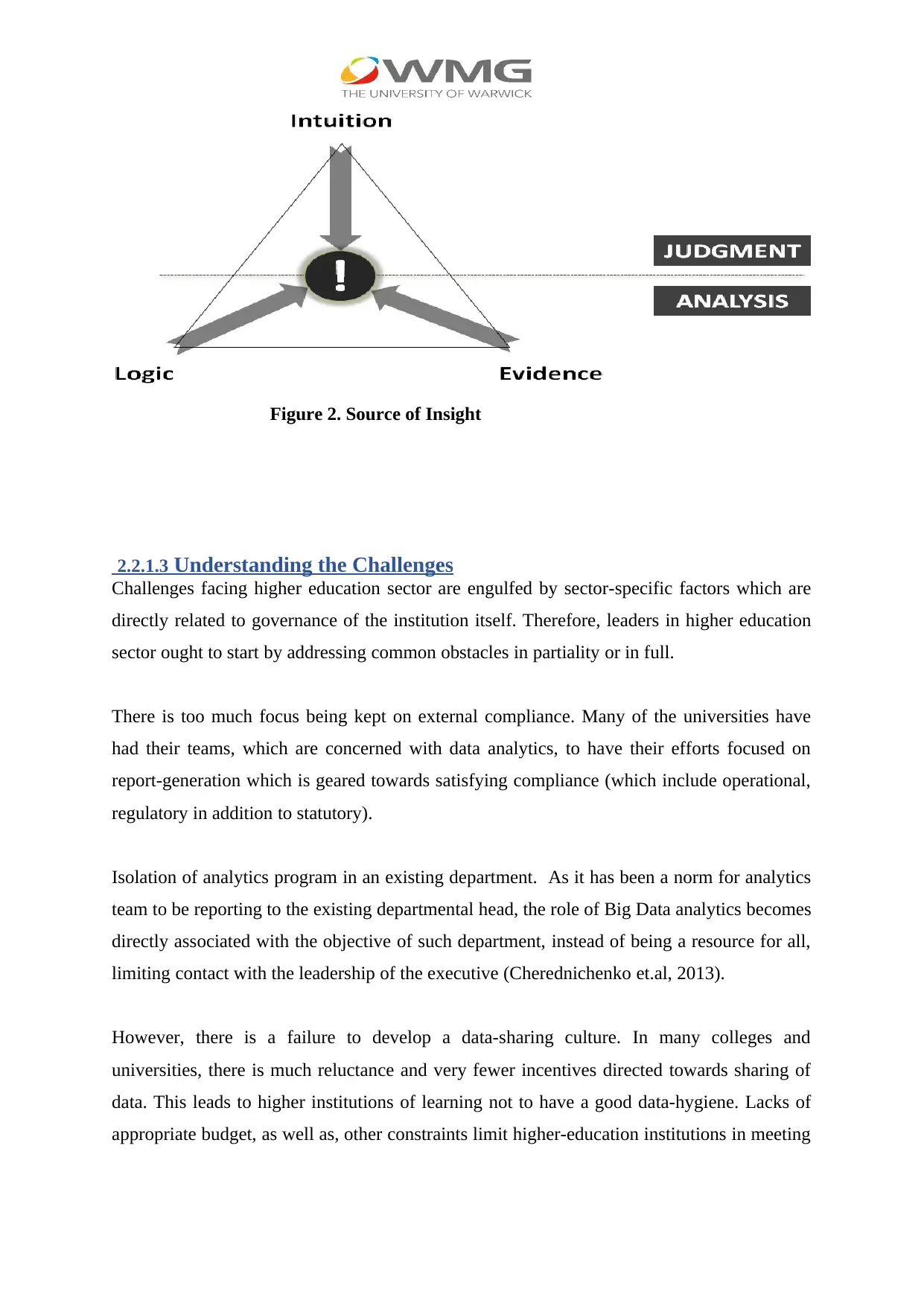
Figure 2. Source of Insight
2.2.1.3 Understanding the Challenges
Challenges facing higher education sector are engulfed by sector-specific factors which are
directly related to governance of the institution itself. Therefore, leaders in higher education
sector ought to start by addressing common obstacles in partiality or in full.
There is too much focus being kept on external compliance. Many of the universities have
had their teams, which are concerned with data analytics, to have their efforts focused on
report-generation which is geared towards satisfying compliance (which include operational,
regulatory in addition to statutory).
Isolation of analytics program in an existing department. As it has been a norm for analytics
team to be reporting to the existing departmental head, the role of Big Data analytics becomes
directly associated with the objective of such department, instead of being a resource for all,
limiting contact with the leadership of the executive (Cherednichenko et.al, 2013).
However, there is a failure to develop a data-sharing culture. In many colleges and
universities, there is much reluctance and very fewer incentives directed towards sharing of
data. This leads to higher institutions of learning not to have a good data-hygiene. Lacks of
appropriate budget, as well as, other constraints limit higher-education institutions in meeting
2.2.1.3 Understanding the Challenges
Challenges facing higher education sector are engulfed by sector-specific factors which are
directly related to governance of the institution itself. Therefore, leaders in higher education
sector ought to start by addressing common obstacles in partiality or in full.
There is too much focus being kept on external compliance. Many of the universities have
had their teams, which are concerned with data analytics, to have their efforts focused on
report-generation which is geared towards satisfying compliance (which include operational,
regulatory in addition to statutory).
Isolation of analytics program in an existing department. As it has been a norm for analytics
team to be reporting to the existing departmental head, the role of Big Data analytics becomes
directly associated with the objective of such department, instead of being a resource for all,
limiting contact with the leadership of the executive (Cherednichenko et.al, 2013).
However, there is a failure to develop a data-sharing culture. In many colleges and
universities, there is much reluctance and very fewer incentives directed towards sharing of
data. This leads to higher institutions of learning not to have a good data-hygiene. Lacks of
appropriate budget, as well as, other constraints limit higher-education institutions in meeting
⊘ This is a preview!⊘
Do you want full access?
Subscribe today to unlock all pages.

Trusted by 1+ million students worldwide
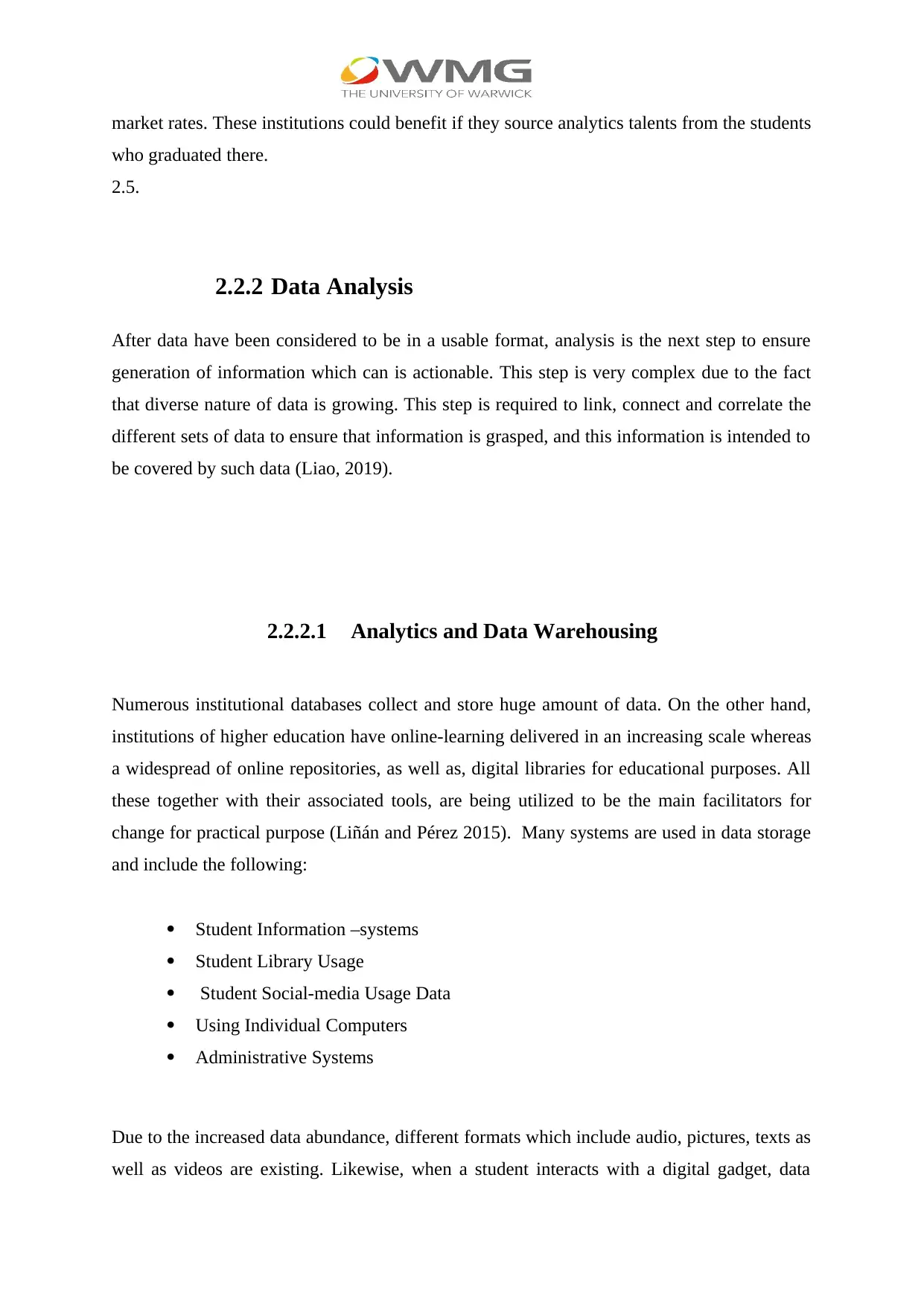
market rates. These institutions could benefit if they source analytics talents from the students
who graduated there.
2.5.
2.2.2 Data Analysis
After data have been considered to be in a usable format, analysis is the next step to ensure
generation of information which can is actionable. This step is very complex due to the fact
that diverse nature of data is growing. This step is required to link, connect and correlate the
different sets of data to ensure that information is grasped, and this information is intended to
be covered by such data (Liao, 2019).
2.2.2.1 Analytics and Data Warehousing
Numerous institutional databases collect and store huge amount of data. On the other hand,
institutions of higher education have online-learning delivered in an increasing scale whereas
a widespread of online repositories, as well as, digital libraries for educational purposes. All
these together with their associated tools, are being utilized to be the main facilitators for
change for practical purpose (Liñán and Pérez 2015). Many systems are used in data storage
and include the following:
Student Information –systems
Student Library Usage
Student Social-media Usage Data
Using Individual Computers
Administrative Systems
Due to the increased data abundance, different formats which include audio, pictures, texts as
well as videos are existing. Likewise, when a student interacts with a digital gadget, data
who graduated there.
2.5.
2.2.2 Data Analysis
After data have been considered to be in a usable format, analysis is the next step to ensure
generation of information which can is actionable. This step is very complex due to the fact
that diverse nature of data is growing. This step is required to link, connect and correlate the
different sets of data to ensure that information is grasped, and this information is intended to
be covered by such data (Liao, 2019).
2.2.2.1 Analytics and Data Warehousing
Numerous institutional databases collect and store huge amount of data. On the other hand,
institutions of higher education have online-learning delivered in an increasing scale whereas
a widespread of online repositories, as well as, digital libraries for educational purposes. All
these together with their associated tools, are being utilized to be the main facilitators for
change for practical purpose (Liñán and Pérez 2015). Many systems are used in data storage
and include the following:
Student Information –systems
Student Library Usage
Student Social-media Usage Data
Using Individual Computers
Administrative Systems
Due to the increased data abundance, different formats which include audio, pictures, texts as
well as videos are existing. Likewise, when a student interacts with a digital gadget, data
Paraphrase This Document
Need a fresh take? Get an instant paraphrase of this document with our AI Paraphraser
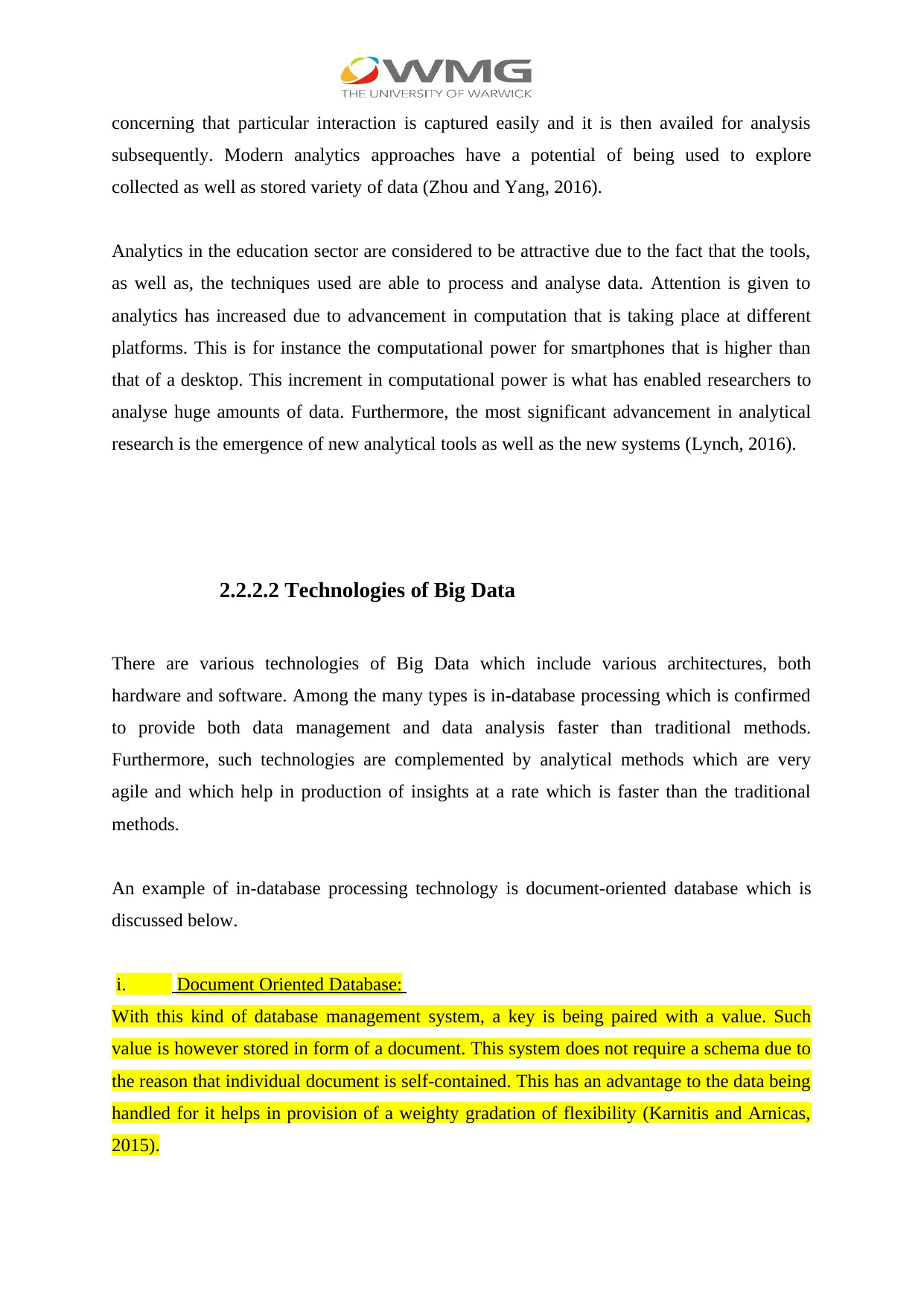
concerning that particular interaction is captured easily and it is then availed for analysis
subsequently. Modern analytics approaches have a potential of being used to explore
collected as well as stored variety of data (Zhou and Yang, 2016).
Analytics in the education sector are considered to be attractive due to the fact that the tools,
as well as, the techniques used are able to process and analyse data. Attention is given to
analytics has increased due to advancement in computation that is taking place at different
platforms. This is for instance the computational power for smartphones that is higher than
that of a desktop. This increment in computational power is what has enabled researchers to
analyse huge amounts of data. Furthermore, the most significant advancement in analytical
research is the emergence of new analytical tools as well as the new systems (Lynch, 2016).
2.2.2.2 Technologies of Big Data
There are various technologies of Big Data which include various architectures, both
hardware and software. Among the many types is in-database processing which is confirmed
to provide both data management and data analysis faster than traditional methods.
Furthermore, such technologies are complemented by analytical methods which are very
agile and which help in production of insights at a rate which is faster than the traditional
methods.
An example of in-database processing technology is document-oriented database which is
discussed below.
i. Document Oriented Database:
With this kind of database management system, a key is being paired with a value. Such
value is however stored in form of a document. This system does not require a schema due to
the reason that individual document is self-contained. This has an advantage to the data being
handled for it helps in provision of a weighty gradation of flexibility (Karnitis and Arnicas,
2015).
subsequently. Modern analytics approaches have a potential of being used to explore
collected as well as stored variety of data (Zhou and Yang, 2016).
Analytics in the education sector are considered to be attractive due to the fact that the tools,
as well as, the techniques used are able to process and analyse data. Attention is given to
analytics has increased due to advancement in computation that is taking place at different
platforms. This is for instance the computational power for smartphones that is higher than
that of a desktop. This increment in computational power is what has enabled researchers to
analyse huge amounts of data. Furthermore, the most significant advancement in analytical
research is the emergence of new analytical tools as well as the new systems (Lynch, 2016).
2.2.2.2 Technologies of Big Data
There are various technologies of Big Data which include various architectures, both
hardware and software. Among the many types is in-database processing which is confirmed
to provide both data management and data analysis faster than traditional methods.
Furthermore, such technologies are complemented by analytical methods which are very
agile and which help in production of insights at a rate which is faster than the traditional
methods.
An example of in-database processing technology is document-oriented database which is
discussed below.
i. Document Oriented Database:
With this kind of database management system, a key is being paired with a value. Such
value is however stored in form of a document. This system does not require a schema due to
the reason that individual document is self-contained. This has an advantage to the data being
handled for it helps in provision of a weighty gradation of flexibility (Karnitis and Arnicas,
2015).
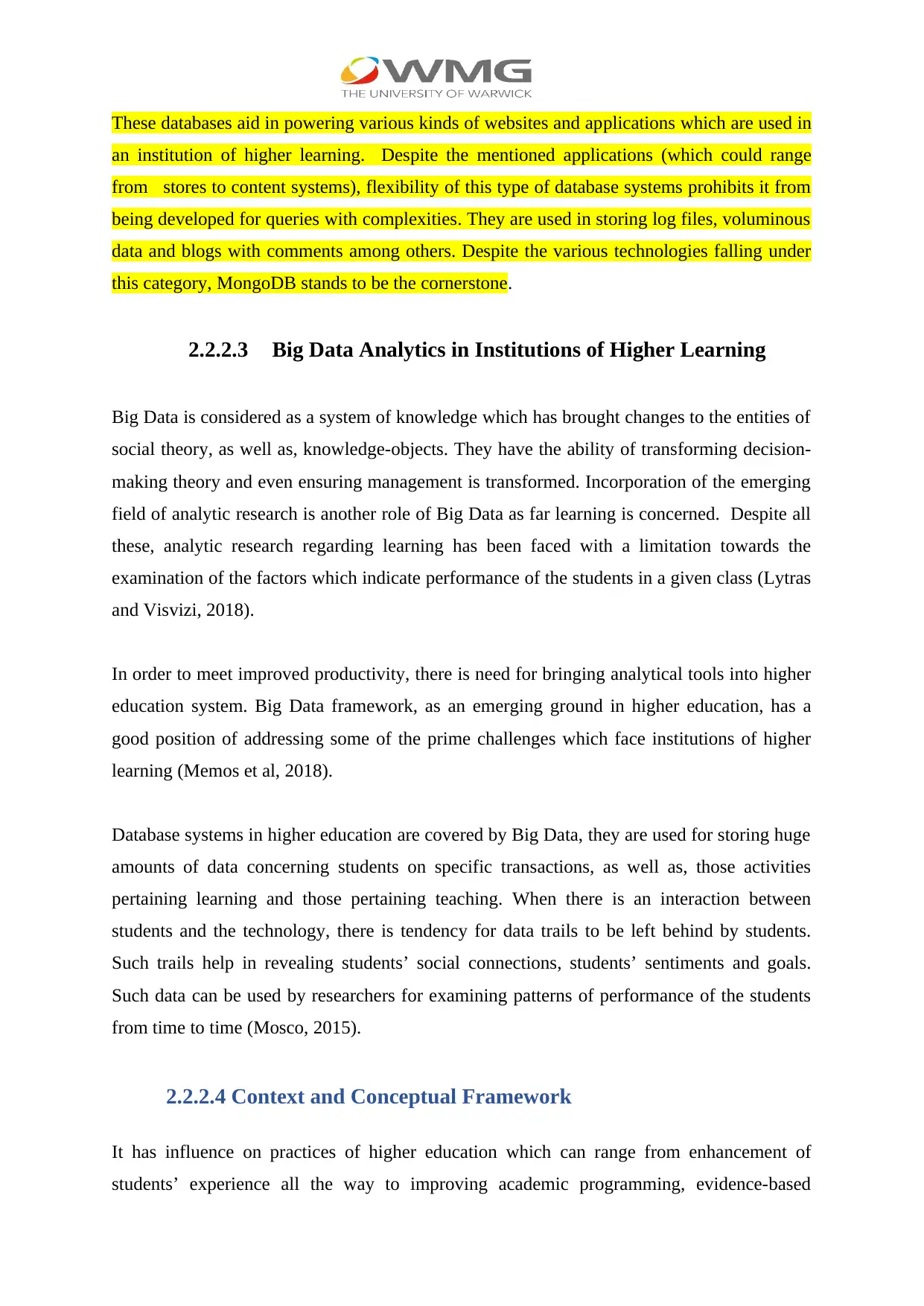
These databases aid in powering various kinds of websites and applications which are used in
an institution of higher learning. Despite the mentioned applications (which could range
from stores to content systems), flexibility of this type of database systems prohibits it from
being developed for queries with complexities. They are used in storing log files, voluminous
data and blogs with comments among others. Despite the various technologies falling under
this category, MongoDB stands to be the cornerstone.
2.2.2.3 Big Data Analytics in Institutions of Higher Learning
Big Data is considered as a system of knowledge which has brought changes to the entities of
social theory, as well as, knowledge-objects. They have the ability of transforming decision-
making theory and even ensuring management is transformed. Incorporation of the emerging
field of analytic research is another role of Big Data as far learning is concerned. Despite all
these, analytic research regarding learning has been faced with a limitation towards the
examination of the factors which indicate performance of the students in a given class (Lytras
and Visvizi, 2018).
In order to meet improved productivity, there is need for bringing analytical tools into higher
education system. Big Data framework, as an emerging ground in higher education, has a
good position of addressing some of the prime challenges which face institutions of higher
learning (Memos et al, 2018).
Database systems in higher education are covered by Big Data, they are used for storing huge
amounts of data concerning students on specific transactions, as well as, those activities
pertaining learning and those pertaining teaching. When there is an interaction between
students and the technology, there is tendency for data trails to be left behind by students.
Such trails help in revealing students’ social connections, students’ sentiments and goals.
Such data can be used by researchers for examining patterns of performance of the students
from time to time (Mosco, 2015).
2.2.2.4 Context and Conceptual Framework
It has influence on practices of higher education which can range from enhancement of
students’ experience all the way to improving academic programming, evidence-based
an institution of higher learning. Despite the mentioned applications (which could range
from stores to content systems), flexibility of this type of database systems prohibits it from
being developed for queries with complexities. They are used in storing log files, voluminous
data and blogs with comments among others. Despite the various technologies falling under
this category, MongoDB stands to be the cornerstone.
2.2.2.3 Big Data Analytics in Institutions of Higher Learning
Big Data is considered as a system of knowledge which has brought changes to the entities of
social theory, as well as, knowledge-objects. They have the ability of transforming decision-
making theory and even ensuring management is transformed. Incorporation of the emerging
field of analytic research is another role of Big Data as far learning is concerned. Despite all
these, analytic research regarding learning has been faced with a limitation towards the
examination of the factors which indicate performance of the students in a given class (Lytras
and Visvizi, 2018).
In order to meet improved productivity, there is need for bringing analytical tools into higher
education system. Big Data framework, as an emerging ground in higher education, has a
good position of addressing some of the prime challenges which face institutions of higher
learning (Memos et al, 2018).
Database systems in higher education are covered by Big Data, they are used for storing huge
amounts of data concerning students on specific transactions, as well as, those activities
pertaining learning and those pertaining teaching. When there is an interaction between
students and the technology, there is tendency for data trails to be left behind by students.
Such trails help in revealing students’ social connections, students’ sentiments and goals.
Such data can be used by researchers for examining patterns of performance of the students
from time to time (Mosco, 2015).
2.2.2.4 Context and Conceptual Framework
It has influence on practices of higher education which can range from enhancement of
students’ experience all the way to improving academic programming, evidence-based
⊘ This is a preview!⊘
Do you want full access?
Subscribe today to unlock all pages.

Trusted by 1+ million students worldwide
1 out of 25
Related Documents
Your All-in-One AI-Powered Toolkit for Academic Success.
+13062052269
info@desklib.com
Available 24*7 on WhatsApp / Email
![[object Object]](/_next/static/media/star-bottom.7253800d.svg)
Unlock your academic potential
Copyright © 2020–2025 A2Z Services. All Rights Reserved. Developed and managed by ZUCOL.




